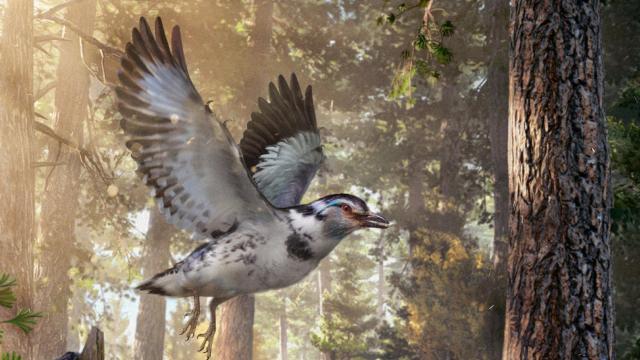The discovery of a 127-million-year-old fossil in northeastern China is filling an important evolutionary gap between modern birds and the winged, dinosaur-like creatures that came before them.
To say that birds evolved from dinosaurs isn’t entirely accurate. Technically speaking, birds are dinosaurs. They just happen to represent the only lineage of dinosaurs that escaped extinction 65 million years ago.
Today, there are an astounding 18,000 bird species on Earth, demonstrating the dramatic extent to which dinosaurs still inhabit the planet.
Despite their ubiquity, the origin and early evolution of birds is still not well understood. Thankfully, a slew of new fossil discoveries over the past few decades, mostly from China, have offered important new insights into this critical stage of dinosaur evolution.
The latest development in this area, the details of which were published this week in Proceedings of the National Academy of Sciences, is the discovery of a 127-million-year-old bird fossil found near the village of Shixia in China’s Hebei Province.
As lead author Min Wang and his colleagues from the Chinese Academy of Sciences point out, this newly identified genus and species, named Jinguofortis perplexus, existed during a pivotal stage in the evolution of flight. It didn’t feature a long bony tail like other flying dinosaurs (the famous archaeopteryx being a good example), instead exhibiting a stubby tail characteristic of modern birds.
Unlike the flying birds we see today, however, J. perplexus hadn’t yet evolved a fan of flight feathers on its stubby tail.
Flying birds with short tails that end in a compound bone are broadly classified as pygostylian birds. Scientists are eager to understand the evolutionary stages leading up to the emergence of these short-tailed avians, which is why the discovery of J. perplexus is such a big deal. In fact, this new species now represents the second-earliest known branch of pygostylian birds.
Aside from its short tail, this early Cretaceous bird featured several other characteristics of note. It had a 69.7cm wingspan, and its jaw boasted a row of small, sharp teeth similar to those seen on its theropod relatives (yes, that chicken on your dinner plate shared a common ancestor with Tyrannosauruses and velociraptors).
The fossil also contained remnants of gizzard stones, which strongly suggests J. perplexus was a plant eater.
Fascinatingly, and unlike other early birds, its third finger consisted of just two bones — an early example of a bird species reducing, or fusing, its finger bones (more on this in just a bit).
The unique shoulder joint of J. perplexus also tells us something about its flying abilities. The major bones of its shoulder are fused together to form a “scapulocoracoid”, or a fused shoulder girdle (unlike modern flying birds, which have a tight joint between unfused bones). The researchers say this may have helped the birds to grow faster and reach maturity quicker than normal.
More significantly, however, this configuration hints at the presence of evolutionary variety, or developmental plasticity, in the development of flight. Considering its body plan and feathers, J. perplexus probably flew slightly differently than birds today. Also, its short, wide wings suggest it lived in dense forests, according to the researchers.
“The authors of this publication are among the foremost authorities in the field of bird-line dinosaur palaeontology and have delivered another clear description of a new taxon,” Dennis Voeten, a palaeontologist at Palacký University in the Czech Republic who was not involved in the study, told Gizmodo. “This work appears to offer a very welcome piece of the puzzle that is the early evolution of flying dinosaurs.”
Among the findings, Voeten found the fusion of the shoulder bones to be the most surprising.
“To me, this illustrates a new insight that is starting to grow: The early evolution of flying dinosaurs was not one direct path to the flight of modern birds but involves a large diversity of evolutionary solutions to the opportunities that flight offers,” he said. “Dinosaurs may have ‘experimented’ with different flight styles and degrees of [flying] proficiency that went extinct together with the non-avian dinosaurs.”
The fused fingers also grabbed Voeten’s attention.
“The hand of Jinguofortis represents a next step that already resembles the highly reduced hand of modern birds, in which bones of the fingers have fused into elements that can efficiently cope with the stresses associated with feathered flight,” he said.
“The recognition of this development in Jinguofortis allows us to better reconstruct the timing and nature of particular adaptations that reflect incremental evolutionary steps from [non-flying] dinosaurs to the bird-like dinosaurs capable of feathered flight.”
Voeten says the discovery of more fossils, both inside and outside of China, will strengthen this line of research further, both in terms of our understanding of J. perplexus and its place within the larger avian family tree. There’s still a lot to learn about this important stage in bird evolution, but it’s getting clearer with each new fossil discovery.
[PNAS]
